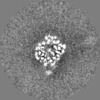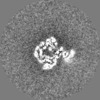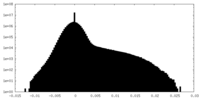+ Open data
Open data
- Basic information
Basic information
| Entry |  | |||||||||
|---|---|---|---|---|---|---|---|---|---|---|
| Title | The structure of EBOV L-VP35-RNA complex (conformation 2) | |||||||||
 Map data Map data | ||||||||||
 Sample Sample |
| |||||||||
 Keywords Keywords | EBOV / Polymerase / Replication / cryo-EM / VIRAL PROTEIN/RNA / VIRAL PROTEIN-RNA complex | |||||||||
| Function / homology |  Function and homology information Function and homology informationsymbiont-mediated suppression of host cytoplasmic pattern recognition receptor signaling pathway via inhibition of IKBKE activity / symbiont-mediated suppression of host cytoplasmic pattern recognition receptor signaling pathway via inhibition of IRF7 activity / GDP polyribonucleotidyltransferase / Hydrolases; Acting on acid anhydrides; In phosphorus-containing anhydrides / Transferases; Transferring one-carbon groups; Methyltransferases / virion component / symbiont-mediated suppression of host cytoplasmic pattern recognition receptor signaling pathway via inhibition of TBK1 activity / symbiont-mediated suppression of host toll-like receptor signaling pathway / host cell cytoplasm / mRNA 5'-cap (guanine-N7-)-methyltransferase activity ...symbiont-mediated suppression of host cytoplasmic pattern recognition receptor signaling pathway via inhibition of IKBKE activity / symbiont-mediated suppression of host cytoplasmic pattern recognition receptor signaling pathway via inhibition of IRF7 activity / GDP polyribonucleotidyltransferase / Hydrolases; Acting on acid anhydrides; In phosphorus-containing anhydrides / Transferases; Transferring one-carbon groups; Methyltransferases / virion component / symbiont-mediated suppression of host cytoplasmic pattern recognition receptor signaling pathway via inhibition of TBK1 activity / symbiont-mediated suppression of host toll-like receptor signaling pathway / host cell cytoplasm / mRNA 5'-cap (guanine-N7-)-methyltransferase activity / RNA-directed RNA polymerase / RNA-directed RNA polymerase activity / GTPase activity / ATP binding Similarity search - Function | |||||||||
| Biological species |  | |||||||||
| Method | single particle reconstruction / cryo EM / Resolution: 3.4 Å | |||||||||
 Authors Authors | Qi P / Yi S | |||||||||
| Funding support |  China, 1 items China, 1 items
| |||||||||
 Citation Citation |  Journal: Nature / Year: 2023 Journal: Nature / Year: 2023Title: Molecular mechanism of de novo replication by the Ebola virus polymerase. Authors: Qi Peng / Bin Yuan / Jinlong Cheng / Min Wang / Siwei Gao / Suran Bai / Xuejin Zhao / Jianxun Qi / George F Gao / Yi Shi /  Abstract: Non-segmented negative-strand RNA viruses, including Ebola virus (EBOV), rabies virus, human respiratory syncytial virus and pneumoviruses, can cause respiratory infections, haemorrhagic fever and ...Non-segmented negative-strand RNA viruses, including Ebola virus (EBOV), rabies virus, human respiratory syncytial virus and pneumoviruses, can cause respiratory infections, haemorrhagic fever and encephalitis in humans and animals, and are considered a substantial health and economic burden worldwide. Replication and transcription of the viral genome are executed by the large (L) polymerase, which is a promising target for the development of antiviral drugs. Here, using the L polymerase of EBOV as a representative, we show that de novo replication of L polymerase is controlled by the specific 3' leader sequence of the EBOV genome in an enzymatic assay, and that formation of at least three base pairs can effectively drive the elongation process of RNA synthesis independent of the specific RNA sequence. We present the high-resolution structures of the EBOV L-VP35-RNA complex and show that the 3' leader RNA binds in the template entry channel with a distinctive stable bend conformation. Using mutagenesis assays, we confirm that the bend conformation of the RNA is required for the de novo replication activity and reveal the key residues of the L protein that stabilize the RNA conformation. These findings provide a new mechanistic understanding of RNA synthesis for polymerases of non-segmented negative-strand RNA viruses, and reveal important targets for the development of antiviral drugs. | |||||||||
| History |
|
- Structure visualization
Structure visualization
| Supplemental images |
|---|
- Downloads & links
Downloads & links
-EMDB archive
| Map data |  emd_36624.map.gz emd_36624.map.gz | 11.8 MB |  EMDB map data format EMDB map data format | |
|---|---|---|---|---|
| Header (meta data) |  emd-36624-v30.xml emd-36624-v30.xml emd-36624.xml emd-36624.xml | 20.4 KB 20.4 KB | Display Display |  EMDB header EMDB header |
| FSC (resolution estimation) |  emd_36624_fsc.xml emd_36624_fsc.xml | 12.8 KB | Display |  FSC data file FSC data file |
| Images |  emd_36624.png emd_36624.png | 34.4 KB | ||
| Filedesc metadata |  emd-36624.cif.gz emd-36624.cif.gz | 7.8 KB | ||
| Others |  emd_36624_half_map_1.map.gz emd_36624_half_map_1.map.gz emd_36624_half_map_2.map.gz emd_36624_half_map_2.map.gz | 140.7 MB 141 MB | ||
| Archive directory |  http://ftp.pdbj.org/pub/emdb/structures/EMD-36624 http://ftp.pdbj.org/pub/emdb/structures/EMD-36624 ftp://ftp.pdbj.org/pub/emdb/structures/EMD-36624 ftp://ftp.pdbj.org/pub/emdb/structures/EMD-36624 | HTTPS FTP |
-Validation report
| Summary document |  emd_36624_validation.pdf.gz emd_36624_validation.pdf.gz | 752.9 KB | Display |  EMDB validaton report EMDB validaton report |
|---|---|---|---|---|
| Full document |  emd_36624_full_validation.pdf.gz emd_36624_full_validation.pdf.gz | 752.5 KB | Display | |
| Data in XML |  emd_36624_validation.xml.gz emd_36624_validation.xml.gz | 19.8 KB | Display | |
| Data in CIF |  emd_36624_validation.cif.gz emd_36624_validation.cif.gz | 25.7 KB | Display | |
| Arichive directory |  https://ftp.pdbj.org/pub/emdb/validation_reports/EMD-36624 https://ftp.pdbj.org/pub/emdb/validation_reports/EMD-36624 ftp://ftp.pdbj.org/pub/emdb/validation_reports/EMD-36624 ftp://ftp.pdbj.org/pub/emdb/validation_reports/EMD-36624 | HTTPS FTP |
-Related structure data
| Related structure data |  8jsnMC 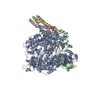 8jslC 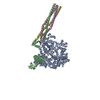 8jsmC M: atomic model generated by this map C: citing same article ( |
|---|---|
| Similar structure data | Similarity search - Function & homology  F&H Search F&H Search |
- Links
Links
| EMDB pages |  EMDB (EBI/PDBe) / EMDB (EBI/PDBe) /  EMDataResource EMDataResource |
|---|---|
| Related items in Molecule of the Month |
- Map
Map
| File |  Download / File: emd_36624.map.gz / Format: CCP4 / Size: 178 MB / Type: IMAGE STORED AS FLOATING POINT NUMBER (4 BYTES) Download / File: emd_36624.map.gz / Format: CCP4 / Size: 178 MB / Type: IMAGE STORED AS FLOATING POINT NUMBER (4 BYTES) | ||||||||||||||||||||||||||||||||||||
|---|---|---|---|---|---|---|---|---|---|---|---|---|---|---|---|---|---|---|---|---|---|---|---|---|---|---|---|---|---|---|---|---|---|---|---|---|---|
| Projections & slices | Image control
Images are generated by Spider. | ||||||||||||||||||||||||||||||||||||
| Voxel size | X=Y=Z: 0.83 Å | ||||||||||||||||||||||||||||||||||||
| Density |
| ||||||||||||||||||||||||||||||||||||
| Symmetry | Space group: 1 | ||||||||||||||||||||||||||||||||||||
| Details | EMDB XML:
|
-Supplemental data
-Half map: #2
| File | emd_36624_half_map_1.map | ||||||||||||
|---|---|---|---|---|---|---|---|---|---|---|---|---|---|
| Projections & Slices |
| ||||||||||||
| Density Histograms |
-Half map: #1
| File | emd_36624_half_map_2.map | ||||||||||||
|---|---|---|---|---|---|---|---|---|---|---|---|---|---|
| Projections & Slices |
| ||||||||||||
| Density Histograms |
- Sample components
Sample components
-Entire : The structure of EBOV L-VP35-RNA complex (conformation 2)
| Entire | Name: The structure of EBOV L-VP35-RNA complex (conformation 2) |
|---|---|
| Components |
|
-Supramolecule #1: The structure of EBOV L-VP35-RNA complex (conformation 2)
| Supramolecule | Name: The structure of EBOV L-VP35-RNA complex (conformation 2) type: complex / ID: 1 / Parent: 0 / Macromolecule list: #1-#3 |
|---|---|
| Source (natural) | Organism:  |
-Macromolecule #1: RNA-directed RNA polymerase L
| Macromolecule | Name: RNA-directed RNA polymerase L / type: protein_or_peptide / ID: 1 / Number of copies: 1 / Enantiomer: LEVO / EC number: RNA-directed RNA polymerase |
|---|---|
| Source (natural) | Organism:  |
| Molecular weight | Theoretical: 252.863734 KDa |
| Recombinant expression | Organism:  Spodoptera (butterflies/moths) Spodoptera (butterflies/moths) |
| Sequence | String: MATQHTQYPD ARLSSPIVLD QCDLVTRACG LYSSYSLNPQ LRNCKLPKHI YRLKYDVTVT KFLSDVPVAT LPIDFIVPIL LKALSGNGF CPVEPRCQQF LDEIIKYTMQ DALFLKYYLK NVGAQEDCVD DHFQEKILSS IQGNEFLHQM FFWYDLAILT R RGRLNRGN ...String: MATQHTQYPD ARLSSPIVLD QCDLVTRACG LYSSYSLNPQ LRNCKLPKHI YRLKYDVTVT KFLSDVPVAT LPIDFIVPIL LKALSGNGF CPVEPRCQQF LDEIIKYTMQ DALFLKYYLK NVGAQEDCVD DHFQEKILSS IQGNEFLHQM FFWYDLAILT R RGRLNRGN SRSTWFVHDD LIDILGYGDY VFWKIPISLL PLNTQGIPHA AMDWYQTSVF KEAVQGHTHI VSVSTADVLI MC KDLITCR FNTTLISKIA EVEDPVCSDY PNFKIVSMLY QSGDYLLSIL GSDGYKIIKF LEPLCLAKIQ LCSKYTERKG RFL TQMHLA VNHTLEEITE IRALKPSQAH KIREFHRTLI RLEMTPQQLC ELFSIQKHWG HPVLHSETAI QKVKKHATVL KALR PIVIF ETYCVFKYSI AKHYFDSQGS WYSVTSDRNL TPGLNSYIKR NQFPPLPMIK ELLWEFYHLD HPPLFSTKII SDLSI FIKD RATAVERTCW DAVFEPNVLG YNPPHKFSTK RVPEQFLEQE NFSIENVLSY AQKLEYLLPQ YRNFSFSLKE KELNVG RTF GKLPYPTRNV QTLCEALLAD GLAKAFPSNM MVVTEREQKE SLLHQASWHH TSDDFGEHAT VRGSSFVTDL EKYNLAF RY EFTAPFIEYC NRCYGVKNVF NWMHYTIPQC YMHVSDYYNP PHNLTLENRN NPPEGPSSYR GHMGGIEGLQ QKLWTSIS C AQISLVEIKT GFKLRSAVMG DNQCITVLSV FPLETDADEQ EQSAEDNAAR VAASLAKVTS ACGIFLKPDE TFVHSGFIY FGKKQYLNGV QLPQSLKTAT RMAPLSDAIF DDLQGTLASI GTAFERSISE TRHIFPCRIT AAFHTFFSVR ILQYHHLGFN KGFDLGQLT LGKPLDFGTI SLALAVPQVL GGLSFLNPEK CFYRNLGDPV TSGLFQLKTY LRMIEMDDLF LPLIAKNPGN C TAIDFVLN PSGLNVPGSQ DLTSFLRQIV RRTITLSAKN KLINTLFHAS ADFEDEMVCK WLLSSTPVMS RFAADIFSRT PS GKRLQIL GYLEGTRTLL ASKIINNNTE TPVLDRLRKI TLQRWSLWFS YLDHCDNILA EALTQITCTV DLAQILREYS WAH ILEGRP LIGATLPCMI EQFKVVWLKP YEQCPQCSNA KQPGGKPFVS VAVKKHIVSA WPNASRISWT IGDGIPYIGS RTED KIGQP AIKPKCPSAA LREAIELASR LTWVTQGSSN SDLLIKPFLE ARVNLSVQEI LQMTPSHYSG NIVHRYNDQY SPHSF MANR MSNSATRLIV STNTLGEFSG GGQSARDSNI IFQNVINYAV ALFDIKFRNT EATDIQYNRA HLHLTKCCTR EVPAQY LTY TSTLDLDLTR YRENELIYDN NPLKGGLNCN ISFDNPFFQG KQLNIIEDDL IRLPHLSGWE LAKTIMQSII SDSNNSS TD PISSGETRSF TTHFLTYPKI GLLYSFGAFV SYYLGNTILR TKKLTLDNFL YYLTTQIHNL PHRSLRILKP TFKHASVM S RLMSIDPHFS IYIGGAAGDR GLSDAARLFL RTSISSFLTF VKEWIINRGT IVPLWIVYPL EGQNPTPVNN FLHQIVELL VHDSSRHQAF KTTINDHVHP HDNLVYTCKS TASNFFHASL AYWRSRHRNS NRKDLTRNSS TGSSTNNSDG HIKRSQEQTT RDPHDGTER SLVLQMSHEI KRTTIPQENT HQGPSFQSFL SDSACGTANP KLNFDRSRHN VKSQDHNSAS KREGHQIISH R LVLPFFTL SQGTRQLTSS NESQTQDEIS KYLRQLRSVI DTTVYCRFTG IVSSMHYKLD EVLWEIENFK SAVTLAEGEG AG ALLLIQK YQVKTLFFNT LATESSIESE IVSGMTTPRM LLPVMSKFHN DQIEIILNNS ASQITDITNP TWFKDQRARL PRQ VEVITM DAETTENINR SKLYEAVHKL ILHHVDPSVL KAVVLKVFLS DTEGMLWLND NLAPFFATGY LIKPITSSAR SSEW YLCLT NFLSTTRKMP HQNHLSCKQV ILTALQLQIQ RSPYWLSHLT QYADCDLHLS YIRLGFPSLE KVLYHRYNLV DSKRG PLVS VTQHLAHLRA EIRELTNDYN QQRQSRTQTY HFIRTAKGRI TKLVNDYLKF FLIVQALKHN GTWQAEFKKL PELISV CNR FYHIRDCNCE ERFLVQTLYL HRMQDSEVKL IERLTGLLSL FPDGLYRFD UniProtKB: RNA-directed RNA polymerase L |
-Macromolecule #2: Polymerase cofactor VP35
| Macromolecule | Name: Polymerase cofactor VP35 / type: protein_or_peptide / ID: 2 / Number of copies: 4 / Enantiomer: LEVO |
|---|---|
| Source (natural) | Organism:  |
| Molecular weight | Theoretical: 37.48943 KDa |
| Recombinant expression | Organism:  Spodoptera (butterflies/moths) Spodoptera (butterflies/moths) |
| Sequence | String: MTTRTKGRGH TVATTQNDRM PGPELSGWIS EQLMTGRIPV NDIFCDIENN PGLCYASQMQ QTKPNPKMRN SQTQTDPICN HSFEEVVQT LASLATVVQQ QTIASESLEQ RITSLENGLK PVYDMAKTIS SLNRVCAEMV AKYDLLVMTT GRATATAAAT E AYWAEHGQ ...String: MTTRTKGRGH TVATTQNDRM PGPELSGWIS EQLMTGRIPV NDIFCDIENN PGLCYASQMQ QTKPNPKMRN SQTQTDPICN HSFEEVVQT LASLATVVQQ QTIASESLEQ RITSLENGLK PVYDMAKTIS SLNRVCAEMV AKYDLLVMTT GRATATAAAT E AYWAEHGQ PPPGPSLYEE SAIRGKIESR DETVPQSVRE AFNNLDSTTS LTEENFGKPD ISAKDLRNIM YDHLPGFGTA FH QLVQVIC KLGKDSNSLD IIHAEFQASL AEGDSPQCAL IQITKRVPIF QDAAPPVIHI RSRGDIPRAC QKSLRPVPPS PKI DRGWVC VFQLQDGKTL GLKI UniProtKB: Polymerase cofactor VP35 |
-Macromolecule #3: The leader sequence of EBOV genome
| Macromolecule | Name: The leader sequence of EBOV genome / type: rna / ID: 3 / Number of copies: 1 |
|---|---|
| Source (natural) | Organism:  |
| Molecular weight | Theoretical: 5.619235 KDa |
| Sequence | String: UUUCUUUUUG UGUGUCCG |
-Macromolecule #4: ZINC ION
| Macromolecule | Name: ZINC ION / type: ligand / ID: 4 / Number of copies: 1 / Formula: ZN |
|---|---|
| Molecular weight | Theoretical: 65.409 Da |
-Experimental details
-Structure determination
| Method | cryo EM |
|---|---|
 Processing Processing | single particle reconstruction |
| Aggregation state | particle |
- Sample preparation
Sample preparation
| Buffer | pH: 7.8 |
|---|---|
| Vitrification | Cryogen name: ETHANE |
- Electron microscopy
Electron microscopy
| Microscope | FEI TITAN KRIOS |
|---|---|
| Image recording | Film or detector model: GATAN K3 (6k x 4k) / Average electron dose: 60.0 e/Å2 |
| Electron beam | Acceleration voltage: 300 kV / Electron source:  FIELD EMISSION GUN FIELD EMISSION GUN |
| Electron optics | Illumination mode: FLOOD BEAM / Imaging mode: BRIGHT FIELD / Nominal defocus max: 3.0 µm / Nominal defocus min: 1.0 µm |
| Experimental equipment |  Model: Titan Krios / Image courtesy: FEI Company |
 Movie
Movie Controller
Controller






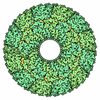

 Z (Sec.)
Z (Sec.) Y (Row.)
Y (Row.) X (Col.)
X (Col.)























